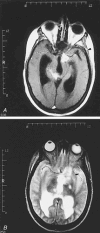Central Nervous System Tuberculosis
- PMID: 28281443
- PMCID: PMC11687486
- DOI: 10.1128/microbiolspec.TNMI7-0044-2017
Central Nervous System Tuberculosis
Abstract
Central nervous system tuberculosis (CNS-TB) takes three clinical forms: meningitis (TBM), intracranial tuberculoma, and spinal arachnoiditis. TBM predominates in the western world and presents as a subacute to chronic meningitis syndrome with a prodrome of malaise, fever, and headache progressing to altered mentation and focal neurologic signs, followed by stupor, coma, and death within five to eight weeks of onset. The CSF formula typically shows a lymphocytic pleocytosis, and low glucose and high protein concentrations. Diagnosis rests on serial samples of CSF for smear and culture, combined with CSF PCR. Brain CT and MRI aid in diagnosis, assessment for complications, and monitoring of the clinical course. In a patient with compatible clinical features, the combination of meningeal enhancement and any degree of hydrocephalus is strongly suggestive of TBM. Vasculitis leading to infarcts in the basal ganglia occurs commonly and is a major determinant of morbidity and mortality. Treatment is most effective when started in the early stages of disease, and should be initiated promptly on the basis of strong clinical suspicion without waiting for laboratory confirmation. The initial 4 drug regimen (isoniazid, rifampin, pyrazinamide, ethambutol) covers the possibility of infection with a resistant strain, maximizes antimicrobial impact, and reduces the likelihood of emerging resistance on therapy. Adjunctive corticosteroid therapy has been shown to reduce morbidity and mortality in all but late stage disease.
Figures


References
-
- Centers for Disease Control and Prevention. 2010. Data and statistics. Centers for Disease Control and Prevention, Atlanta, GA. http://www.cdc.gov/tb/surv/statistics/default.htm.
-
- Centers for Disease Control and Prevention. October 2015. Reported Tuberculosis in the United States, 2014. Centers for Disease Control and Prevention, Atlanta, GA. http://www.cdc.gov/tb/statistics/reports/2014.
-
- Centers for Disease Control and Prevention. 2005. Extrapulmonary tuberculosis cases and percentages by site of disease: reporting areas, 2005. Centers for Disease Control and Prevention, Atlanta, GA. http://www.cdc.gov/tb/surv2005/PDF/tabl27.pdf.
Publication types
MeSH terms
Substances
Supplementary concepts
LinkOut - more resources
Full Text Sources
Other Literature Sources

